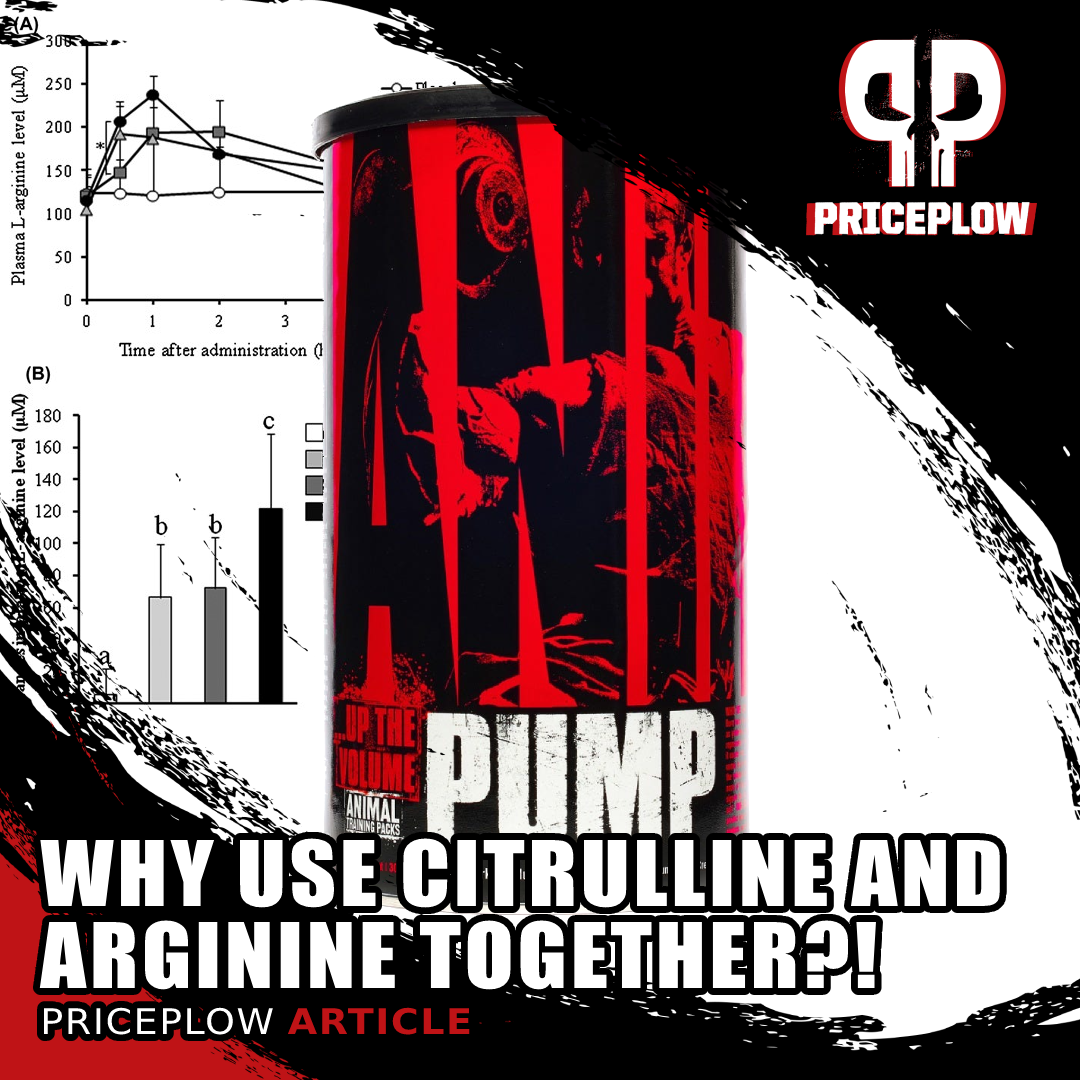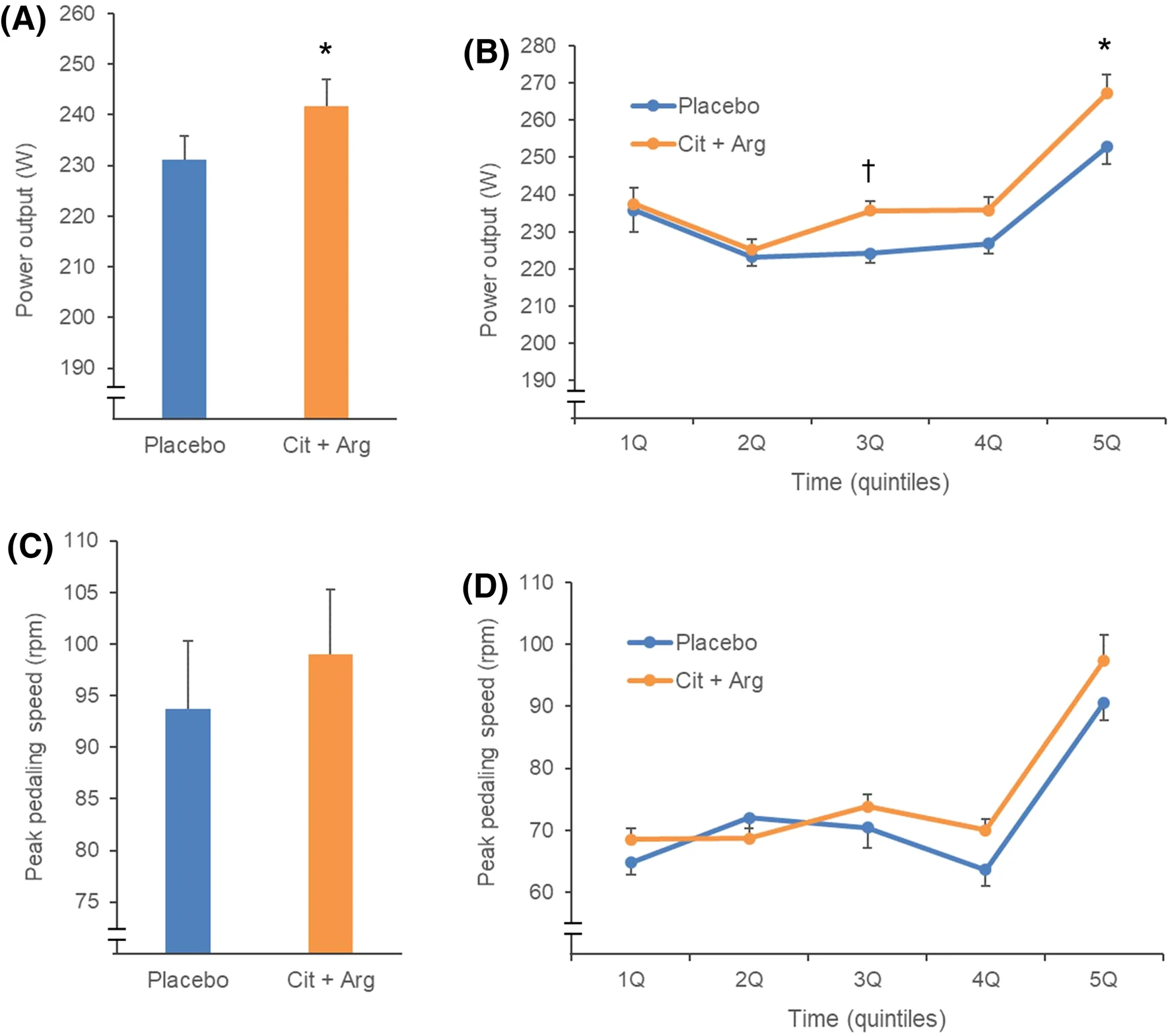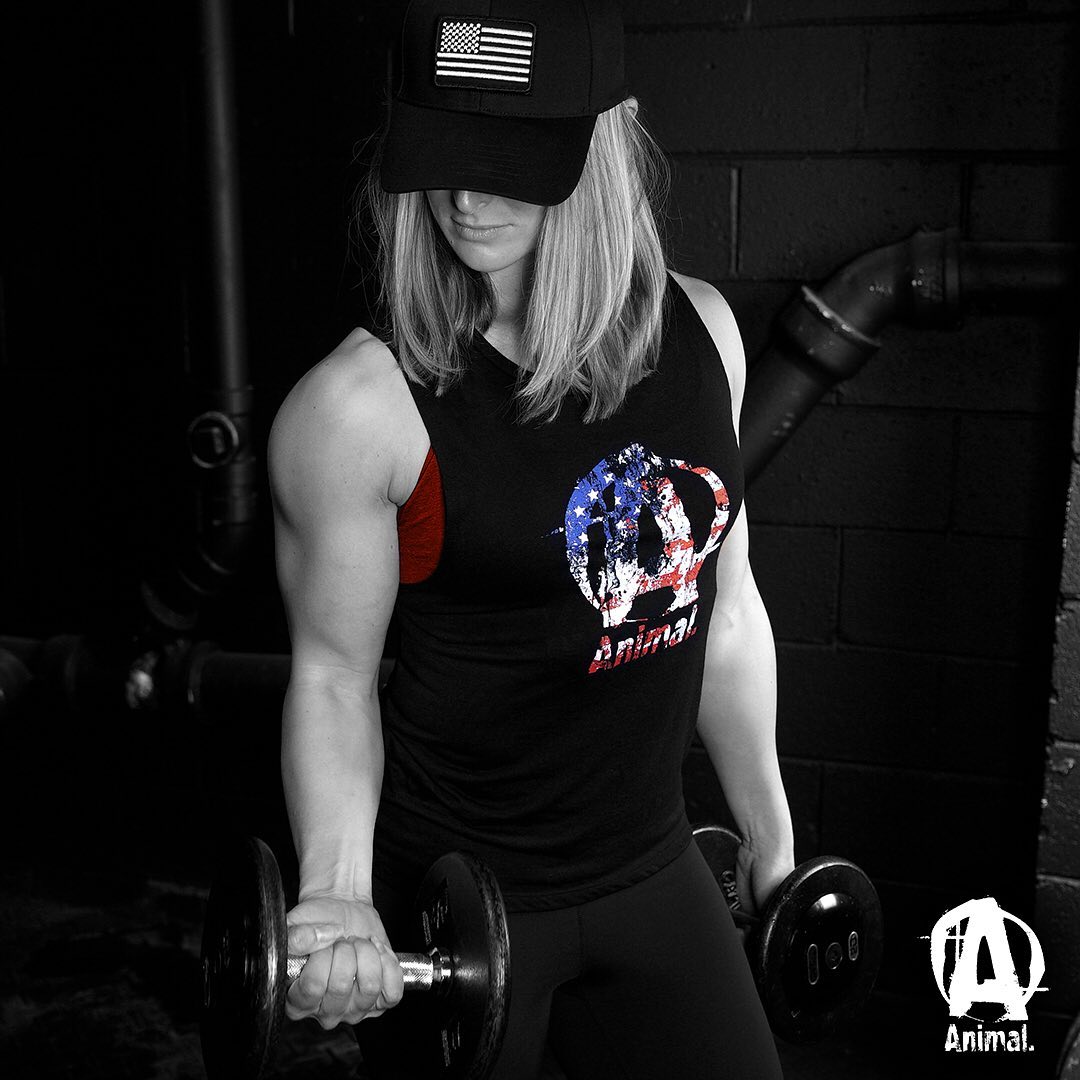There's a lot to digest in Universal Nutrition's Animal Pump line of pre workout supplements (including Animal Pump packs and the Animal Pump Pre-Workout Non-Stim powder), and Universal has come up with a couple of great formulas to suit different needs. However, if you compare those products' ingredient labels, you'll see one common denominator: a combination of the amino acid L-citrulline and some form of arginine.
Arginine and citrulline: two nitric oxide boosting amino acids

Rather than completely replace arginine with citrulline, should we consider pairing them together instead? Turns out, this is what Animal's done in both of their Animal Pump pre workouts!
Why is it that Universal tends to use this combination of aminos? Because both ingredients can boost the production of nitric oxide (NO), a gas produced by certain cells in the body that will trigger vasodilation, the expansion of your body's blood vessels.[1] This in turn will improve the circulation of your blood, and when it comes to maximizing the benefits of exercise, circulation is king. Better circulation means a more efficient delivery of nutrients and fuel to your cells, helping you to both push yourself harder and recover faster post-workout. It also means lower blood pressure and less strain on your heart -- the opposite effect of what caffeine does.
And it also means better pumps when weight training - and that's something that all of us love.
But why both citrulline and arginine?
"But wait," you might be asking, "why do they use arginine to boost NO. Don't people just use citrulline nowadays?"

Are you an animal? The legendary company full of strongmen and strongwomen continues to get stronger itself
The answer is partly that Universal Nutrition is an old-school company, with a gritty, no-nonsense demographic that's enjoyed arginine for years. Back in "the day," right around the so-called "Golden Age of Bodybuilding," everybody was supplementing with just arginine to boost NO, and it felt good, so it makes sense that Universal would keep some arginine in their formula.
But the other, more compelling reason is the science: it turns out that arginine and citrulline combined are better than either one of them in isolation for maximizing NO production. It turns out that by keeping both ingredients together, Universal has been ahead of the majority of the industry in their use of this combination, so today, we want to shine a light on why it works.
First, you can sign up for our our Universal Nutrition news alerts and see the prices on Animal Pump paks, and then let's get into the science:
Universal Animal Pump – Deals and Price Drop Alerts
Get Price Alerts
No spam, no scams.
Disclosure: PricePlow relies on pricing from stores with which we have a business relationship. We work hard to keep pricing current, but you may find a better offer.
Posts are sponsored in part by the retailers and/or brands listed on this page.
This area is reserved for Team PricePlow's upcoming Ingredients video.
Subscribe to our channel and sign up for notifications so you catch it when it goes live!
A primer on Nitric Oxide and the arginine-citrulline cycle
First, how does NO production itself work? Let's take a look at the arginine-citrulline cycle:
As an FYI, this is part of a greater arginine biosynthesis system:

The Arginine Biosynthesis System. Image courtesy Wikimedia, with our red edits demonstrating the arginine citrulline cycle at the top-right
There are several inputs to the metabolic cycle that ultimately creates nitric oxide. For our purposes, citrulline and arginine are the ones we want to look at, because those are what people typically supplement to help this cycle, thus boosting the production of NO.
One thing you'll probably notice from looking at this graph is that arginine is the most direct precursor to nitric oxide. So, it would make the most sense to just supplement with lots of arginine, right? Not so fast -- oral arginine supplements are poorly absorbed by the body, because it is "strongly trapped in the gastrointestinal tract and the hepatic tissue, where it is extensively catabolized by arginase".[2]
In other words, oral arginine gets stuck in the stomach and the liver, where a special enzyme turns it into a different amino acid before it can reach the bloodstream.[3-6] This is also known as the first-pass effect, and research shows that citrulline gets converted into arginine in the kidneys, bypassing arginine's digestive breakdown.[6]
Some oral arginine survives, but large doses are required when taken alone
Now, some of the oral arginine you take will survive and reach the bloodstream, but enough of it is lost that "high doses of 6–14.2 g/day are needed to improve exercise function in healthy persons".[7] This is an impractical dose. It costs way more than it should for the effect you get, and also, most of us don't want to take whole tablespoons of isolated amino acid supplements every day. You'd probably have to take it multiple times per day, too, since the half-life of ingested arginine is short, and "plasma Arg levels returned to the baseline within 4 h after the ingestion of 2.0 g of Arg".[7]
When L-Citrulline alone beats L-arginine alone
This is why scientists began looking at supplementing citrulline, the other main NO precursor, instead of arginine. Unlike arginine, citrulline is not as easily broken down in the stomach or the liver, so it has no problems reaching the bloodstream (and kidneys) where it can be converted into arginine, theoretically raising blood arginine levels more effectively than arginine itself. And whenever it's been put to the test, using citrulline has turned out to be a pretty good strategy at boosting plasma arginine and nitric oxide levels.
Let's look at one specific instance where oral citrulline was shown to outperform oral arginine in raising blood levels of arginine. In a 2008 study by Schwedhelm et al., 20 participants received a form of citrulline or arginine, or a placebo.[8] The researchers then measured the concentration of arginine in their blood at different time intervals, and used that to calculate the Area Under the Curve (AUC), which is a way to measure the overall effect that an intervention (in this case, the supplement) has on someone.
Here's what they found:
The highlighted doses are a great basis for direct comparison, since they're similar in size by weight. As you can see, a near-equivalent dose of citrulline absolutely blew arginine out of the water in terms of both maximum concentration and area under the curve. In fact, only the smallest dose of citrulline did as poorly as either of the arginine preparations.
So we should all just supplement with citrulline, right? Well, that's what most of the industry did for quite a while.
But as it turns out, there's an even better way:
Enter the Combo: Citrulline and Arginine Combined
Turns out there's a little bit more to the cit-arg cycle than we initially thought. The presence of citrulline will actually inhibit the action of arginase, preventing that enzyme from degrading orally-administered arginine.[2] In other words, if you give someone citrulline with arginine, the original rationale for preferring citrulline ironically evaporates! So we're potentially in a situation where the best effect is to use them together. However, depending on the strength of citrulline's ability to inhibit arginase, we'd still like to achieve statistical significance over citrulline alone.
The only way to find out is by putting it to the test, and that's exactly what Suzuki et al. did with their 2017 study in Osaka, Japan.[2] 45 healthy Japanese volunteers were divided into three groups:
- one group received 2.0 grams of citrulline,
- another 2.0 grams of arginine,
- and the third group got 1.0 grams of both citrulline and arginine.
This is great study design, because matching all the doses by weight will give us a good picture of the efficiency of each one.
There's a ton of data to break down in this study, so we won't do it all here -- if you're interested, a link to the full study is in the bibliography below.[2] But some highlights are shown above to the right.
You can see right away that cit+arg was far superior to either citrulline or arginine alone in terms of maximum (or peak) blood arginine concentration. However, as we were discussing above, that doesn't necessarily mean the total effect was greater. For that, we need to look at the AUC or Area Under the Curve:

Arginine and Citrulline together raise plasma arginine more than equivalent doses of each one individually![2]
It works! Improved plasma arginine and nitric oxide levels when combined
Once again, a combination of citrulline and arginine was significantly better than either citrulline or arginine, and vastly superior to placebo.[7] The total exposure of arginine in the blood of subjects who got the combination dose was almost twice what we observe in someone who isn't supplementing. And with plasma arginine surviving longer, nitric oxide levels were also better in the arginine + citrulline group!
Does performance increase as well?
That's great, but now that we've figured out the best way to increase the levels of arginine and nitric oxide in the blood, the million dollar question is whether that was enough to translate into real-world advantages. What happens to athletes' performance if you give them a combination of citrulline and arginine?

With the improved arginine status, we get improved nitric oxide levels, better blood flow and circulation... and ultimately, better performance![7]
That's the question that a similar study, conducted by a lot of the same researchers as Suzuki 2017, set out to answer. In Suzuki et al., 2019, college soccer players were given 1.2 grams per day of citrulline and 1.2 grams per day of arginine for seven days, and then subjected to a test that measured their power output on a stationary bicycle for 10 minutes of continuous pedaling.
The difference in mean power output between the cit+arg group and placebo was 242 ± 24 vs. 231 ± 21 W, respectively. That's about a 5% difference -- this can be the decisive advantage in an evenly-matched athletic contest, or just in maximizing the benefits of your training. It's even more intriguing when you put it in context with the researchers' other findings: they also noticed that "subjective perceptions of "leg muscle soreness" and "ease of pedaling" were also significantly improved in the Cit + Arg group".[7] That's a big deal: all athletes know that feeling less mentally and physically fatigued can give them a significant edge on the field.
Also works in animal models
While we focus on the human-based studies above,[2,7] it's worth mentioning that this method was first tested in an animal models in 2014, where it also succeeded.[9] In that study, both rats and New Zealand white rabbits were used, and the researchers concluded both that "oral l-citrulline plus l-arginine rapidly raises plasma l-arginine levels" and "blood flow is also significantly increased by l-citrulline plus l-arginine".[9]
Cit + Arg and the Minimum Effective Dose
In the world of supplementation, or biohacking, many users try to find the minimal effective dose. There are lots of reasons for this: generally, smaller doses cost less, both to manufacture and to ship. Also, if there are any unwanted effects associated with the substance being dosed, they will be minimized by minimizing the dose. In the case of isolated amino acids such as arginine, the most common expected side effect of taking large doses would be nausea -- nothing too serious -- but still something that is better avoided if possible.
How big of a dose would produce something like stomach upset? Well, the research on orally administered arginine indicates that "relatively large doses of 5–15 g/day would be required to improve endothelial function in humans".[9] The upper end of that range, 15 grams, could definitely cause an upset stomach, especially in sensitive persons.
So why take 15 grams of arginine alone, when we see a clinical effect on blood arginine levels with a dose of just 1 gram of citrulline, combined with 1 gram of arginine? Why take 4 grams of citrulline, when 2 grams of the combination will have a similar effect? Good question, and in the land of sports nutrition, we often get stuck in the "more more more" line of thinking, but when prices are on the rise or supply chain issues loom, it may be time to think a bit smarter.
For these reasons and more, good supplement formulation is always about optimizing the efficiency of ingredients, and first finding the minimal effective dose. Using the minimal effective dose is good for your wallet, good for your health, and good for your taste buds. We don't always think this way in sports nutrition, but when it comes to supplementation, less can be more.
So next time you see arginine and citrulline together on a label, understand that it's done for a reason - the two ingredients play off of each other extremely well in order to meet our end goals.
Stimulant-based and stimulant-free options

38 ingredients in 8 complexes. Are you ready to get cut and learn a ton along the way? Then keep reading... this Animal Cuts educational article goes well beyond just the ingredients.
One thing we've always liked about the Animal Pak philosophy is that when stimulants are added, they're in a separate pill. This is the case with both Animal Pump and Animal Cuts. This means you don't have to take the stims if you don't want them, keeping things flexible.
To some gym goers today, stimulant-free probably sounds like heresy. No caffeine? Everybody knows that stimulants are great for boosting energy and improving fat oxidation, and that caffeine in particular is a great ergogenic aid, meaning it increases your body's capacity for physical work. We discuss much of this in our article on Animal Fury.
But needless to say, sometimes you want options, and with Animal, you get a lot of them. We just find that not enough people are combining arginine and citrulline together when chasing nitric oxide pumps.
Animal Pump Pre-Workout Non-Stim uses Nitrosigine
Finally, it's worth mentioning that next to its citrulline, Animal Pump Pre-Workout Non-Stim uses Nitrosigine, which is inositol-stabilized arginine silicate patented and made by Nutrition21. While this is a form of arginine, it stands apart from the straight L-arginine + L-citrulline research discussed above, and has its own way of reducing arginase.[10]
Both Animal Pump supplements -- the original packs and the Animal Pump Pre-Workout Non-Stim powder -- also use efficacious doses of creatine on top of their different arginine/citrulline combinations, which we love to see.
Conclusion: L-Arginine isn't dead yet, but don't use it alone for NO
Far too often in the sports nutrition niche of the dietary supplement industry, we chase the "next big thing" without thinking about where we came from. For years, companies have been trying to improve pumps by "fixing" L-arginine - and Nutrition21 did just that with Nitrosigine.
However, another way to "fix" L-arginine is to use its most common replacement -- L-citrulline -- alongside it, rather than in place of it. When that's done, you can actually get statistically significant increases in plasma arginine and nitric oxide levels without dosing 10 grams of powder. For those who like capsules or don't want GI distress, it's an option always worth exploring.
And Animal's been doing it all along.
Universal Animal Pump – Deals and Price Drop Alerts
Get Price Alerts
No spam, no scams.
Disclosure: PricePlow relies on pricing from stores with which we have a business relationship. We work hard to keep pricing current, but you may find a better offer.
Posts are sponsored in part by the retailers and/or brands listed on this page.








Comments and Discussion (Powered by the PricePlow Forum)